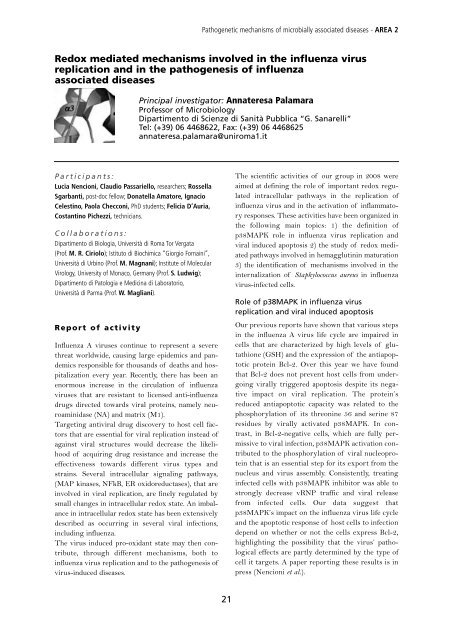download report - Istituto Pasteur
download report - Istituto Pasteur
download report - Istituto Pasteur
Create successful ePaper yourself
Turn your PDF publications into a flip-book with our unique Google optimized e-Paper software.
P a r t i c i p a n t s :<br />
Lucia Nencioni, Claudio Passariello, researchers; Rossella<br />
Sgarbanti, post-doc fellow; Donatella Amatore, Ignacio<br />
Celestino, Paola Checconi, PhD students; Felicia D’Auria,<br />
Costantino Pichezzi, technicians.<br />
C o l l a b o r a t i o n s :<br />
Dipartimento di Biologia, Università di Roma Tor Vergata<br />
(Prof. M. R. Ciriolo); <strong>Istituto</strong> di Biochimica “Giorgio Fornaini”,<br />
Università di Urbino (Prof. M. Magnani); Institute of Molecular<br />
Virology, University of Monaco, Germany (Prof. S. Ludwig);<br />
Dipartimento di Patologia e Medicina di Laboratorio,<br />
Università di Parma (Prof. W. Magliani).<br />
Report of activity<br />
Influenza A viruses continue to represent a severe<br />
threat worldwide, causing large epidemics and pandemics<br />
responsible for thousands of deaths and hospitalization<br />
every year. Recently, there has been an<br />
enormous increase in the circulation of influenza<br />
viruses that are resistant to licensed anti-influenza<br />
drugs directed towards viral proteins, namely neuroaminidase<br />
(NA) and matrix (M1).<br />
Targeting antiviral drug discovery to host cell factors<br />
that are essential for viral replication instead of<br />
against viral structures would decrease the likelihood<br />
of acquiring drug resistance and increase the<br />
effectiveness towards different virus types and<br />
strains. Several intracellular signaling pathways,<br />
(MAP kinases, NFkB, ER oxidoreductases), that are<br />
involved in viral replication, are finely regulated by<br />
small changes in intracellular redox state. An imbalance<br />
in intracellular redox state has been extensively<br />
described as occurring in several viral infections,<br />
including influenza.<br />
The virus induced pro-oxidant state may then contribute,<br />
through different mechanisms, both to<br />
influenza virus replication and to the pathogenesis of<br />
virus-induced diseases.<br />
Pathogenetic mechanisms of microbially associated diseases - AREA 2<br />
Redox mediated mechanisms involved in the influenza virus<br />
replication and in the pathogenesis of influenza<br />
associated diseases<br />
Principal investigator: Annateresa Palamara<br />
Professor of Microbiology<br />
Dipartimento di Scienze di Sanità Pubblica “G. Sanarelli”<br />
Tel: (+39) 06 4468622, Fax: (+39) 06 4468625<br />
annateresa.palamara@uniroma1.it<br />
21<br />
The scientific activities of our group in 2008 were<br />
aimed at defining the role of important redox regulated<br />
intracellular pathways in the replication of<br />
influenza virus and in the activation of inflammatory<br />
responses. These activities have been organized in<br />
the following main topics: 1) the definition of<br />
p38MAPK role in influenza virus replication and<br />
viral induced apoptosis 2) the study of redox mediated<br />
pathways involved in hemagglutinin maturation<br />
3) the identification of mechanisms involved in the<br />
internalization of Staphylococcus aureus in influenza<br />
virus-infected cells.<br />
Role of p38MAPK in influenza virus<br />
replication and viral induced apoptosis<br />
Our previous <strong>report</strong>s have shown that various steps<br />
in the influenza A virus life cycle are impaired in<br />
cells that are characterized by high levels of glutathione<br />
(GSH) and the expression of the antiapoptotic<br />
protein Bcl-2. Over this year we have found<br />
that Bcl-2 does not prevent host cells from undergoing<br />
virally triggered apoptosis despite its negative<br />
impact on viral replication. The protein’s<br />
reduced antiapoptotic capacity was related to the<br />
phosphorylation of its threonine 56 and serine 87<br />
residues by virally activated p38MAPK. In contrast,<br />
in Bcl-2-negative cells, which are fully permissive<br />
to viral infection, p38MAPK activation contributed<br />
to the phosphorylation of viral nucleoprotein<br />
that is an essential step for its export from the<br />
nucleus and virus assembly. Consistently, treating<br />
infected cells with p38MAPK inhibitor was able to<br />
strongly decrease vRNP traffic and viral release<br />
from infected cells. Our data suggest that<br />
p38MAPK’s impact on the influenza virus life cycle<br />
and the apoptotic response of host cells to infection<br />
depend on whether or not the cells express Bcl-2,<br />
highlighting the possibility that the virus’ pathological<br />
effects are partly determined by the type of<br />
cell it targets. A paper <strong>report</strong>ing these results is in<br />
press (Nencioni et al.).








